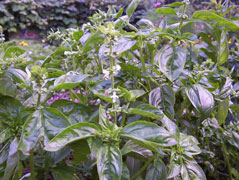


Home
Flowers &
Indoor Plants
Fruits & Nuts
Ornamentals
Vegetables
Special Topics
Resources
Glossary

 |
What about it? Basil is an annual herb and a member of the Mint family. It will grow up to 2 feet tall and is decorated with many long leaves of a dark shiny-green color. The tiny white flowers form a spike arrangement around the top of the stems. Basil is native to India, Africa, Japan, Persia, and Malaysia. What is it used for? The plant gives off a strong spicy odor and is very popular in cooking. It is common in herb gardens as a border plant. It also is reputed to be an excellent companion plant for tomatoes, and tastes very good when prepared with them. Where does it grow? How do we grow it? Basil likes moist soil and sunshine. Basil also grows well in organic conditions, so load that compost onto your herb patch before you plant! What are its primary problems? Basil is sensitive to frost so be careful not to plant it too early. How do we propagate it? Sow the seeds in rows, 1/4 inch deep and 12 inches apart. Plants can be started indoors and moved out as the weather warms up. How do we harvest and store it? Pinching back the tips of the herb before it flowers will make it bushier and promote a longer growing season. Freshly picked basil to season foods and sauces is a wonderful treat. The best time to harvest basil is right before flowering. Dry the leaves on a screen or by hanging in a pantry. After they are dried, store them in an air-tight container in a dark room. Storing the herbs in a well-lit place will decrease their potency.
© Copyright, Department of Horticulture, Cornell University. |

